Overview
This article presents five essential steps for mastering the stakeholder analysis matrix in project management:
- Identifying stakeholders
- Analyzing their influence and interests
- Developing tailored engagement strategies
- Continuously monitoring and updating the matrix
Such a comprehensive approach is backed by evidence demonstrating that effective stakeholder engagement significantly enhances project success rates. By prioritizing communication and addressing the needs of influential stakeholders, managers can ensure the successful delivery of their projects. Therefore, it is imperative to adopt these strategies to optimize stakeholder relationships and drive project success.
Introduction
The landscape of project management is often shaped by a diverse array of stakeholders, each wielding varying degrees of influence and interest. The stakeholder analysis matrix emerges as an indispensable tool, enabling project managers to strategically categorize these individuals and tailor their engagement efforts accordingly.
However, the challenge lies in effectively utilizing this matrix to identify key players and adapt to the ever-changing dynamics of stakeholder relationships.
How can managers harness the power of the stakeholder analysis matrix to ensure successful project outcomes while navigating the complexities of stakeholder engagement? This question underscores the necessity for a robust approach to stakeholder management, one that not only recognizes the importance of each stakeholder but also actively engages them in the project lifecycle.
Define the Stakeholder Analysis Matrix
The stakeholder analysis matrix in project management serves as a vital visual tool, classifying individuals based on their influence and engagement levels in an initiative. Typically represented as a grid, one axis indicates the level of influence—ranging from high to low—while the other reflects the level of interest. This matrix empowers managers to identify which stakeholders require focused attention and involvement, ensuring that their needs and concerns are effectively addressed. By mastering this matrix, managers can prioritize their communication and engagement strategies, ultimately leading to more successful outcomes.
Moreover, understanding the stakeholder analysis matrix in project management allows for a strategic approach to managing stakeholders. It facilitates the identification of key players who can significantly impact the initiative's success. Consequently, by engaging with these stakeholders appropriately, managers can foster stronger relationships and enhance collaboration, driving better results.
In conclusion, leveraging the stakeholder analysis matrix in project management is essential for any manager seeking to optimize stakeholder engagement. By applying this tool, you can ensure that your initiatives are not only well-supported but also aligned with the interests of those involved. Take action now to integrate this powerful matrix into your management practices and witness the transformative effects on your project outcomes.
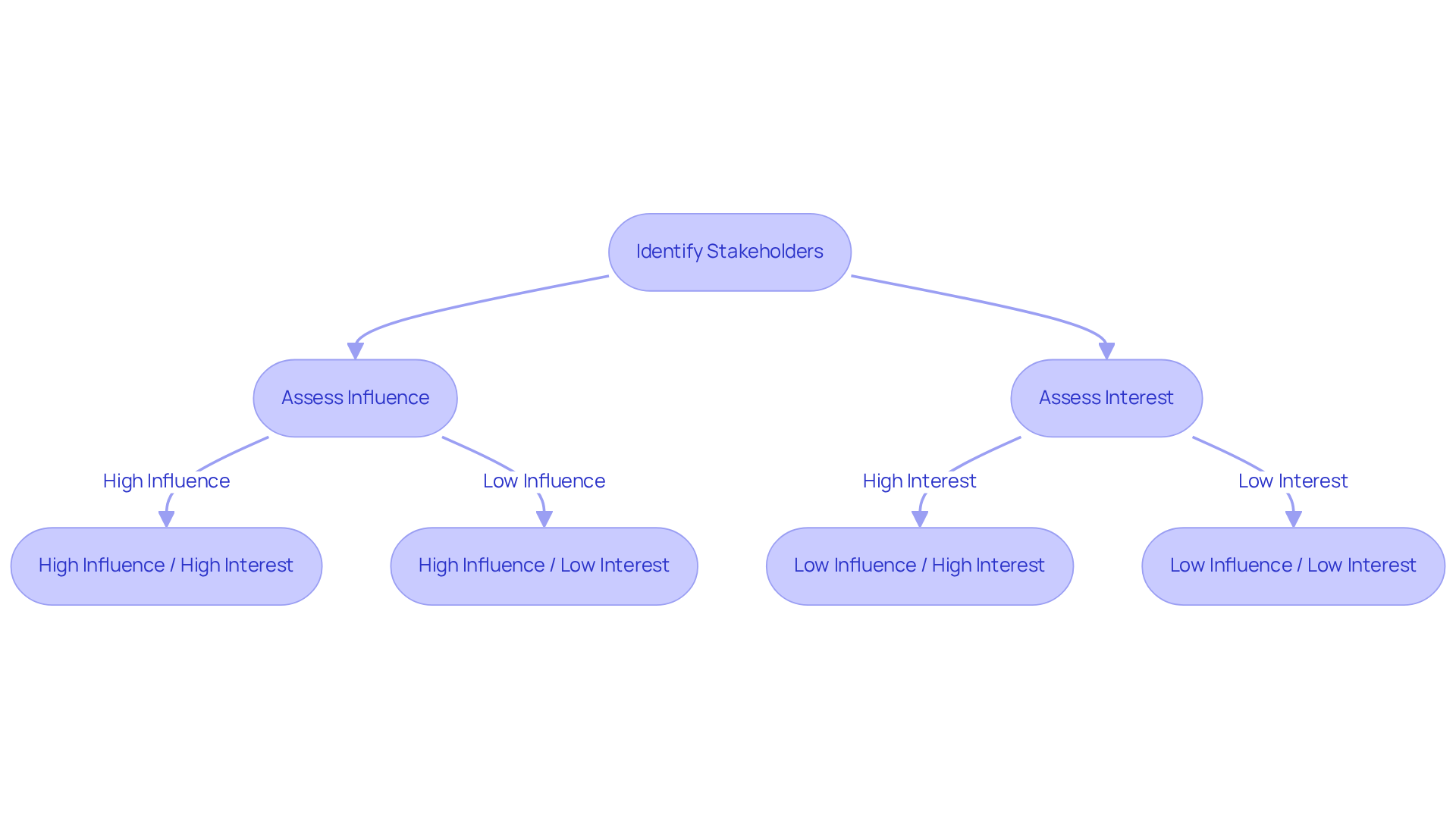
Identify Stakeholders
Recognizing interested parties is a vital initial step in guaranteeing the success of any endeavor, which can be effectively done using a stakeholder analysis matrix in project management. Begin by brainstorming all individuals, groups, or organizations that may be impacted by or have an interest in your project. This includes internal participants such as team members, management, and various departments, as well as external stakeholders like clients, suppliers, and regulatory bodies.
To facilitate this process, utilize tools such as participant registers or organizational charts, which are integral to a comprehensive participant management framework, to systematically document your findings. Engaging in discussions with your team can help ensure that no important parties are overlooked, thereby promoting a thorough identification process.
As Warren G. Bennis astutely noted, "Leaders must gain the trust of their teams, their organizations, and their supporters before trying to secure their backing." This foundational step is essential for effective engagement and participant analysis using the stakeholder analysis matrix in project management, ultimately driving transformational change within your organization and contributing to sustainable growth.
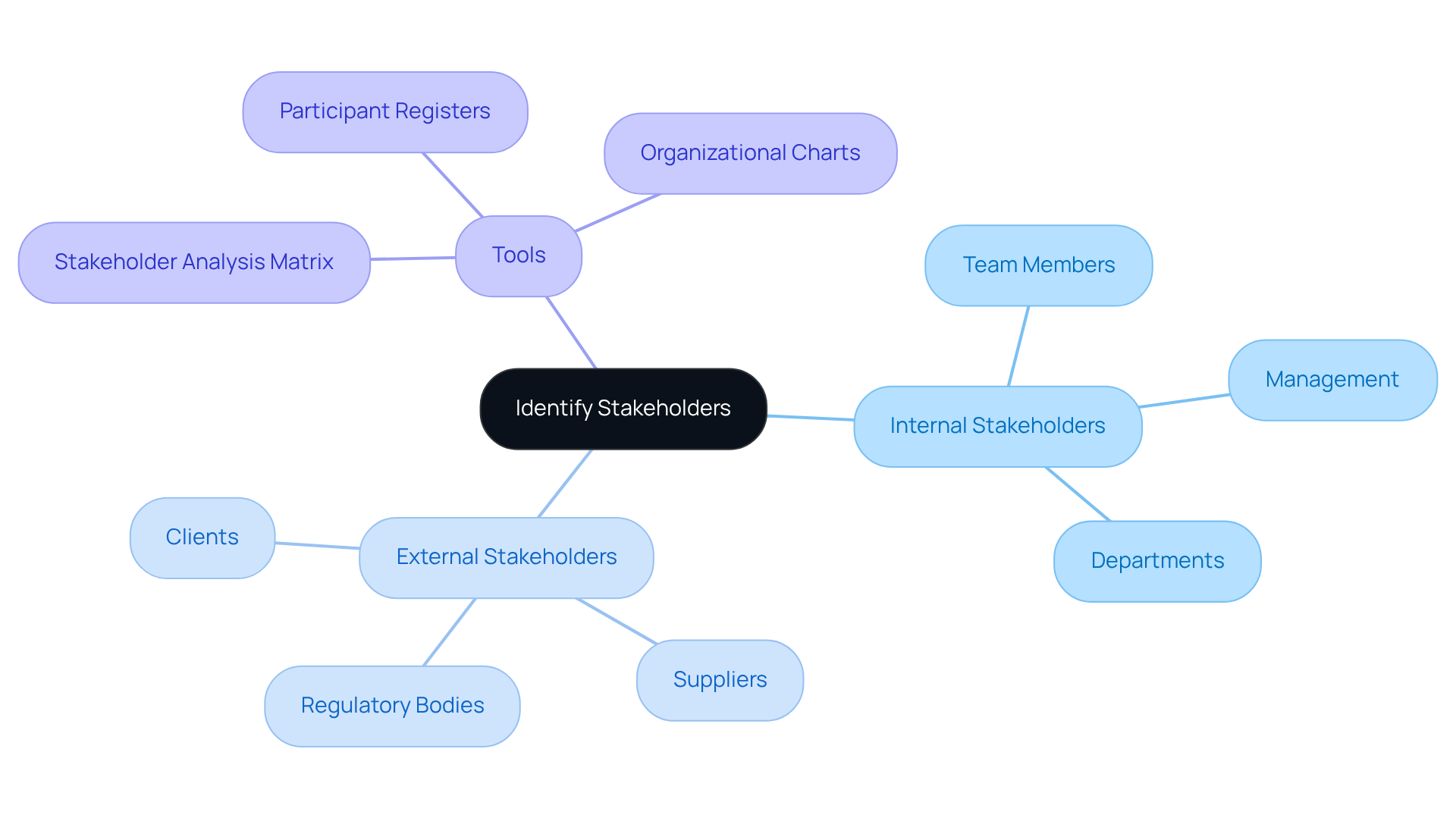
Analyze Stakeholder Influence and Interests
Recognizing the involved parties is just the beginning; it is crucial to assess their impact and concerns using the Influence Analysis Matrix. This powerful tool maps each participant according to their influence on the project and their level of concern regarding its outcomes. For example, parties identified as having significant influence and high engagement must be managed closely to ensure their needs and concerns are effectively addressed. Conversely, those with low power and low interest may require minimal oversight. This strategic examination utilizes a stakeholder analysis matrix in project management, which not only clarifies the dynamics of interest group interactions but also prioritizes communication efforts, enabling managers to focus on individuals who can significantly influence success.
Studies reveal that initiatives with robust participant involvement strategies succeed 83% of the time, compared to just 32% for those lacking such strategies. As Marc Benioff aptly stated, 'The purpose of business isn't solely to generate profits for shareholders — it's also about enhancing the condition of the world and promoting value for all parties involved.' Therefore, understanding the impact of interested parties is essential for improving project outcomes and achieving organizational goals.
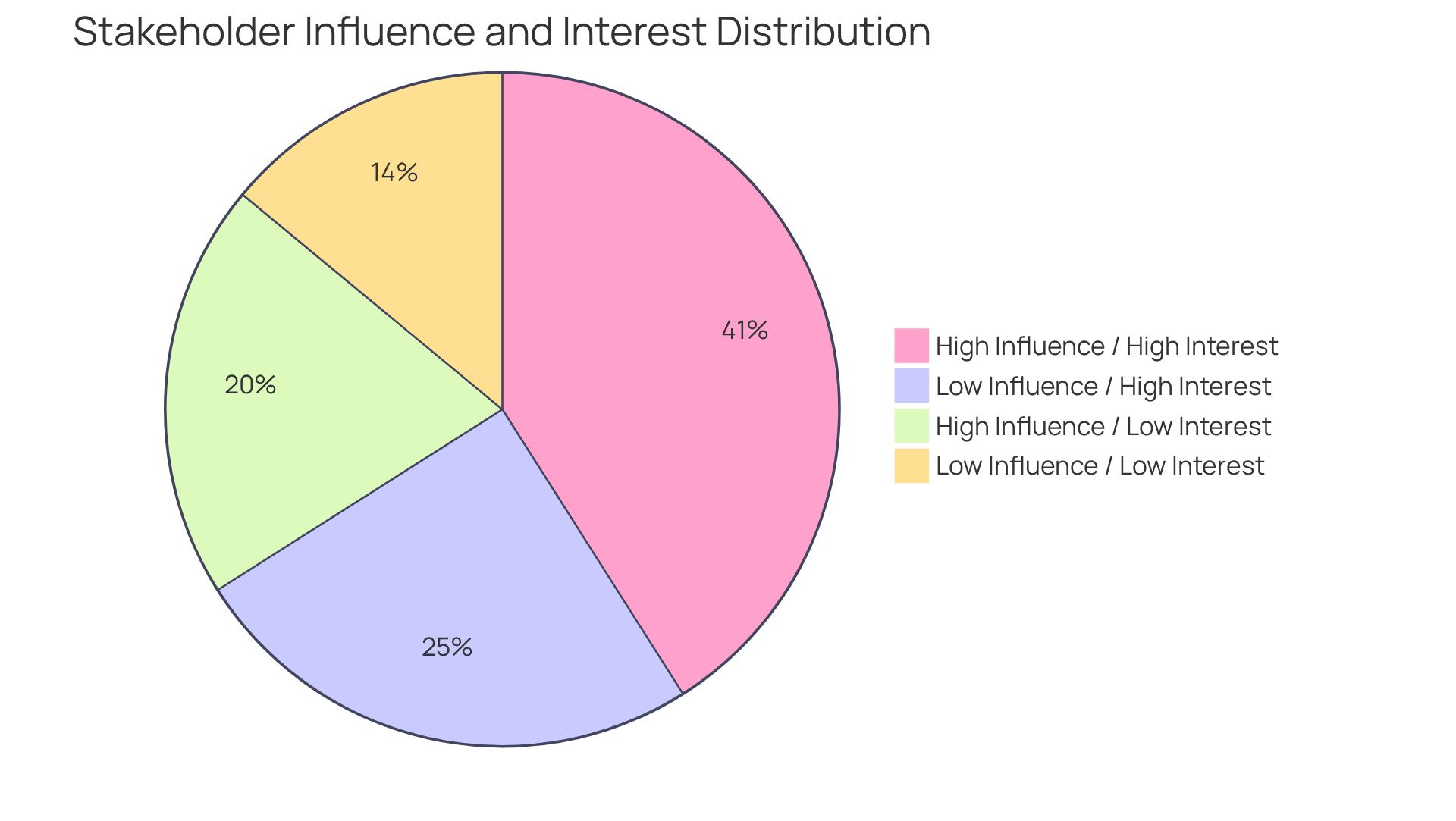
Develop Engagement Strategies
Understanding the influence and priorities of involved parties is crucial for developing tailored interaction strategies using a stakeholder analysis matrix in project management. For individuals identified as high-power and high-interest in the stakeholder analysis matrix in project management, it is essential to prioritize regular communication and actively involve them in decision-making processes to effectively leverage their influence. Conversely, for those who exhibit strong enthusiasm but possess limited influence, it is vital to maintain their engagement through consistent updates and feedback sessions, which can be facilitated by utilizing a stakeholder analysis matrix in project management to ensure they feel valued and informed. Meanwhile, individuals with minimal interest and limited influence should receive regular updates to keep them informed of developments without overwhelming them. This strategic approach utilizes a stakeholder analysis matrix in project management to not only foster positive relationships but also align participants with organizational goals, ultimately improving success rates.
Research indicates that organizations employing effective strategies to engage interested parties can significantly minimize resource wastage, as 12% of resources are often lost due to inadequate management practices. Furthermore, groups that utilize management software with integrated communication capabilities have reported a 52% improvement in team interaction, underscoring the importance of technology in engagement strategies. Notably, only 23% of organizations currently utilize management software, highlighting a substantial opportunity for improvement in engaging involved parties. By implementing these customized strategies, managers can enhance communication, increase participant satisfaction, and drive success, particularly as the management software market is projected to grow significantly in the coming years.
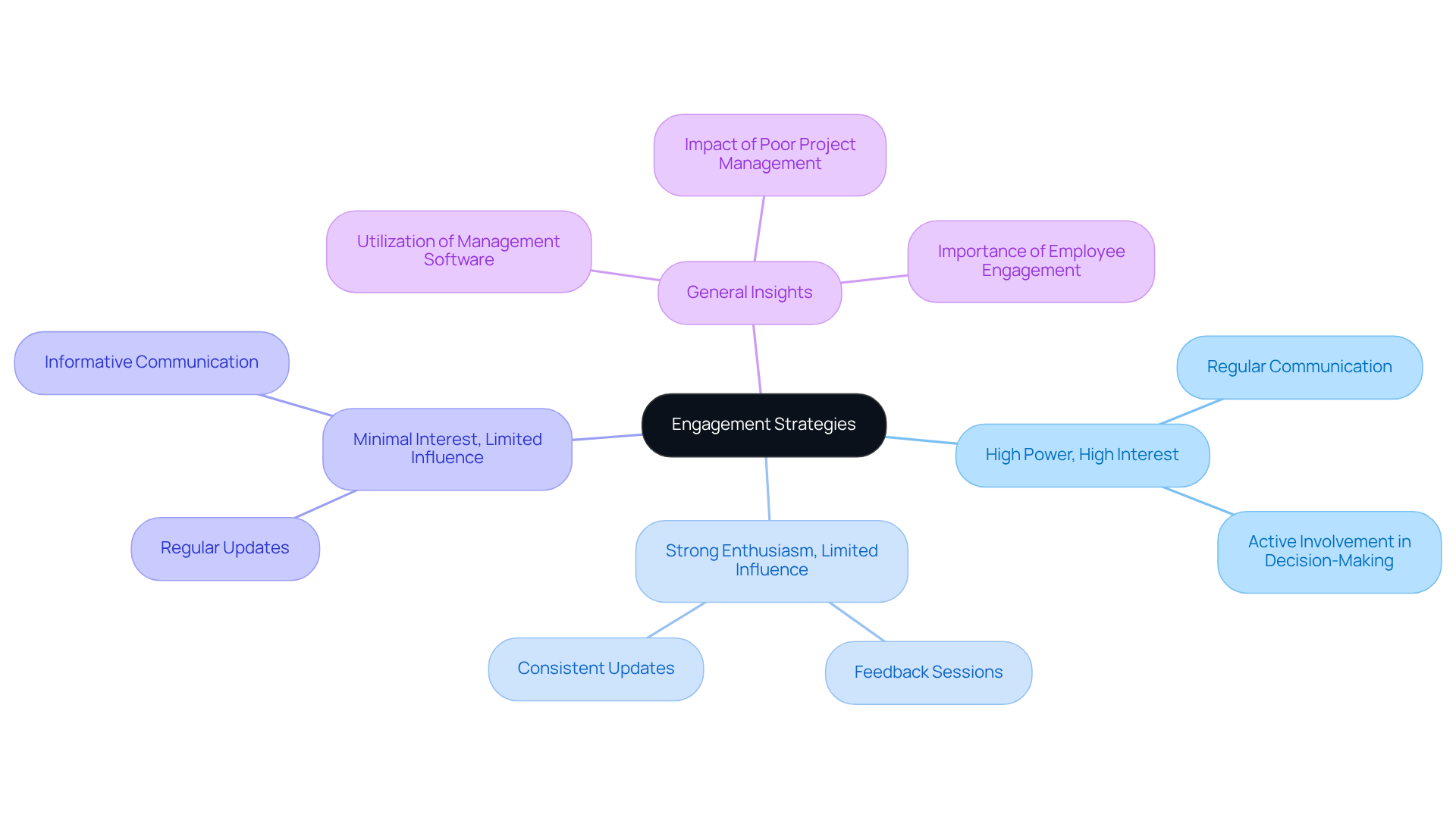
Monitor and Update the Stakeholder Analysis Matrix
Stakeholder dynamics are inherently fluid, evolving throughout the project lifecycle. It is essential to regularly monitor and update the stakeholder analysis matrix in project management. Schedule consistent assessments to evaluate shifts in participant influence or interest, and adjust your engagement strategies accordingly. This proactive approach enables you to address emerging issues and sustain robust connections with involved parties.
Engaging with stakeholders for feedback is vital, as it facilitates the enhancement of your strategies and ensures their needs are consistently met. Research indicates that initiatives with regular updates to the stakeholder analysis matrix in project management enjoy significantly higher success rates, highlighting the importance of this practice.
As Winston Churchill aptly stated, while planning is crucial, flexibility is equally important to adapt to unforeseen circumstances. By adopting this mindset, project managers can navigate complexities and cultivate a collaborative environment that drives project success.
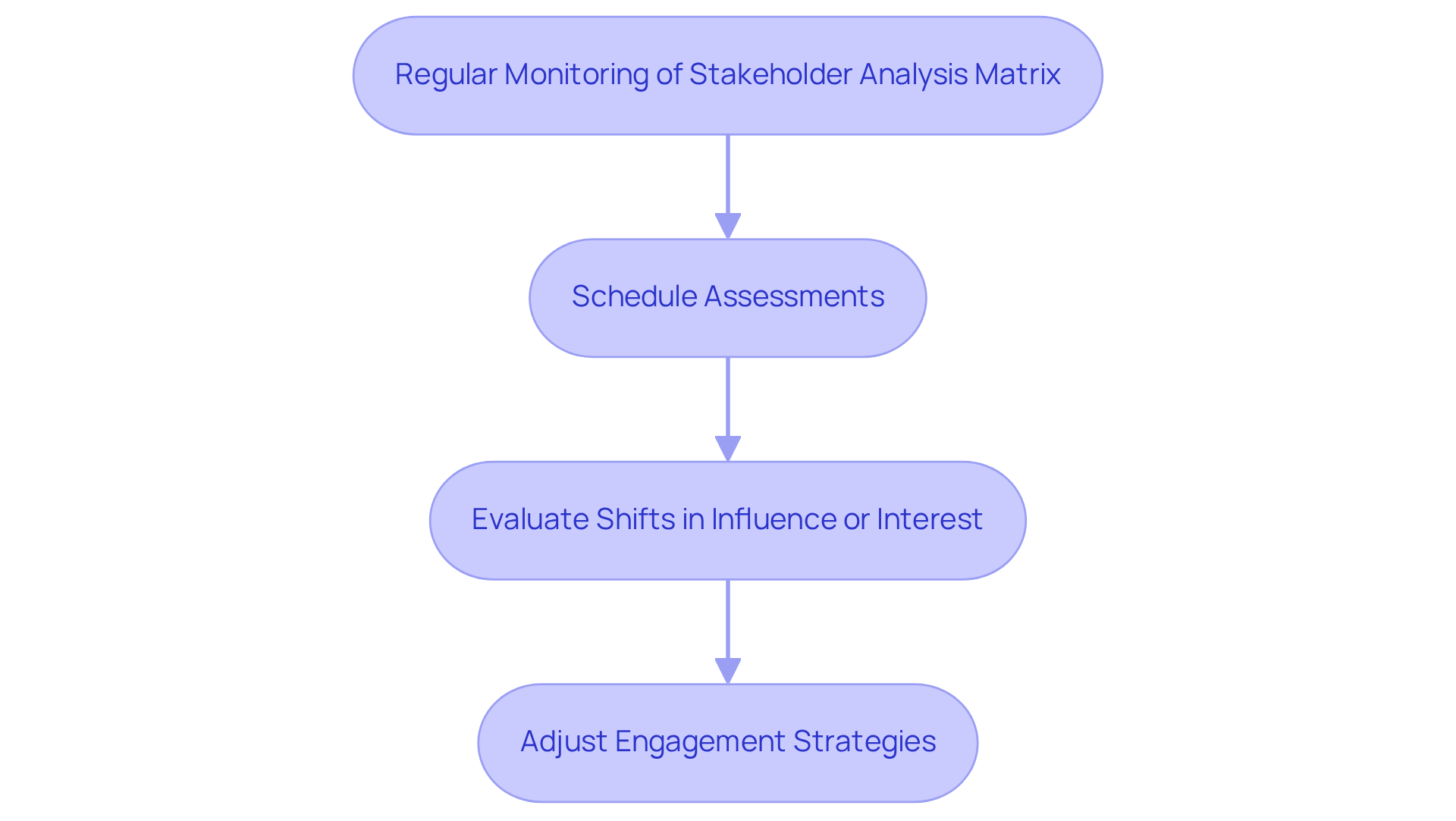
Conclusion
Mastering the stakeholder analysis matrix is essential for project managers who seek to effectively navigate the complexities of stakeholder engagement. This strategic tool not only classifies stakeholders based on their influence and interest but also empowers managers to prioritize their communication and engagement efforts. Consequently, project managers can ensure that the needs and concerns of key stakeholders are addressed, ultimately leading to more successful project outcomes.
The article outlines a comprehensive five-step approach to utilizing the stakeholder analysis matrix:
- Identifying stakeholders
- Analyzing their influence and interests
- Developing tailored engagement strategies
- Continuously monitoring the matrix
Each step is crucial for fostering strong relationships and enhancing collaboration. By employing these strategies, organizations can minimize resource wastage and improve overall project success rates.
In a world where stakeholder dynamics are constantly evolving, the ability to adapt and refine engagement strategies is paramount. By integrating the stakeholder analysis matrix into project management practices, managers can not only enhance communication but also align stakeholder interests with organizational goals. Embracing this approach is not merely a best practice; it is a necessary step towards achieving transformational change and sustainable growth in any project endeavor.
Frequently Asked Questions
What is the stakeholder analysis matrix in project management?
The stakeholder analysis matrix is a visual tool used in project management to classify individuals based on their influence and engagement levels. It is typically represented as a grid, with one axis indicating the level of influence (high to low) and the other reflecting the level of interest.
How does the stakeholder analysis matrix benefit project managers?
The matrix helps managers identify which stakeholders require focused attention and involvement, ensuring their needs and concerns are effectively addressed. It allows for prioritization of communication and engagement strategies, leading to more successful project outcomes.
Why is identifying stakeholders important in project management?
Recognizing interested parties is crucial for the success of any project. It ensures that all individuals, groups, or organizations that may be impacted or have an interest in the project are considered, which fosters comprehensive engagement and support.
What methods can be used to identify stakeholders?
Stakeholders can be identified by brainstorming all relevant parties, utilizing tools like participant registers or organizational charts, and engaging in discussions with team members to ensure that no important stakeholders are overlooked.
How does engaging with stakeholders affect project outcomes?
By appropriately engaging with key stakeholders, managers can foster stronger relationships and enhance collaboration, which drives better results and ensures that initiatives are well-supported and aligned with the interests of those involved.




